Samyak Datta
Sid
Movie Gen: A Cast of Media Foundation Models
Oct 17, 2024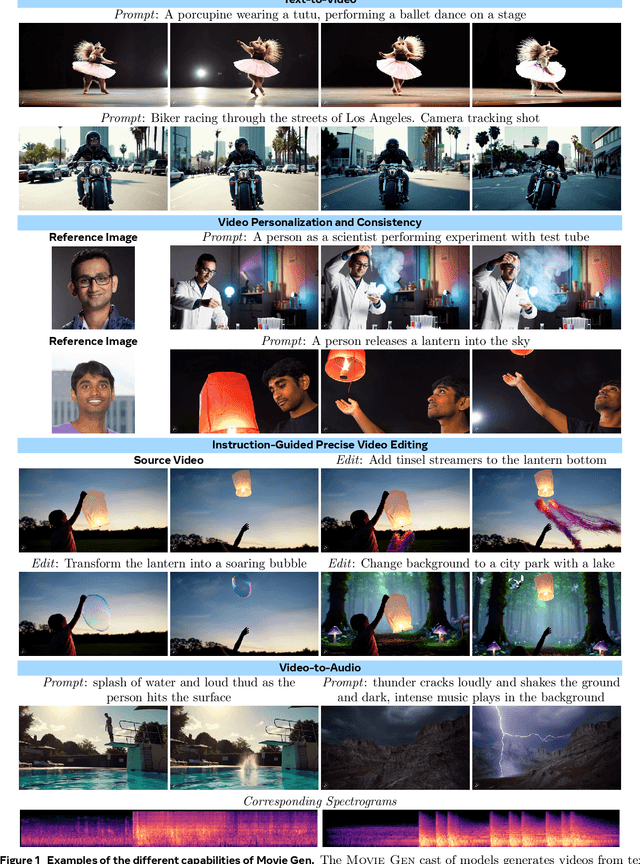

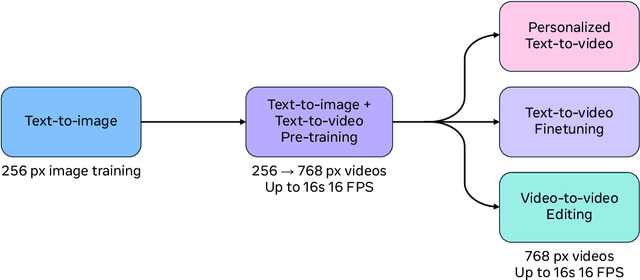
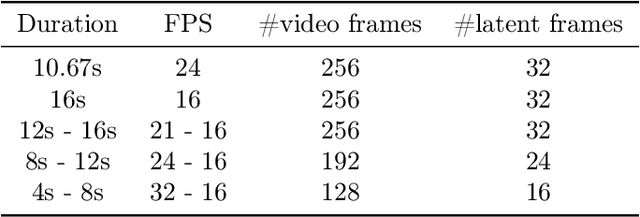
Abstract:We present Movie Gen, a cast of foundation models that generates high-quality, 1080p HD videos with different aspect ratios and synchronized audio. We also show additional capabilities such as precise instruction-based video editing and generation of personalized videos based on a user's image. Our models set a new state-of-the-art on multiple tasks: text-to-video synthesis, video personalization, video editing, video-to-audio generation, and text-to-audio generation. Our largest video generation model is a 30B parameter transformer trained with a maximum context length of 73K video tokens, corresponding to a generated video of 16 seconds at 16 frames-per-second. We show multiple technical innovations and simplifications on the architecture, latent spaces, training objectives and recipes, data curation, evaluation protocols, parallelization techniques, and inference optimizations that allow us to reap the benefits of scaling pre-training data, model size, and training compute for training large scale media generation models. We hope this paper helps the research community to accelerate progress and innovation in media generation models. All videos from this paper are available at https://go.fb.me/MovieGenResearchVideos.
The Llama 3 Herd of Models
Jul 31, 2024Abstract:Modern artificial intelligence (AI) systems are powered by foundation models. This paper presents a new set of foundation models, called Llama 3. It is a herd of language models that natively support multilinguality, coding, reasoning, and tool usage. Our largest model is a dense Transformer with 405B parameters and a context window of up to 128K tokens. This paper presents an extensive empirical evaluation of Llama 3. We find that Llama 3 delivers comparable quality to leading language models such as GPT-4 on a plethora of tasks. We publicly release Llama 3, including pre-trained and post-trained versions of the 405B parameter language model and our Llama Guard 3 model for input and output safety. The paper also presents the results of experiments in which we integrate image, video, and speech capabilities into Llama 3 via a compositional approach. We observe this approach performs competitively with the state-of-the-art on image, video, and speech recognition tasks. The resulting models are not yet being broadly released as they are still under development.
DISGO: Automatic End-to-End Evaluation for Scene Text OCR
Aug 25, 2023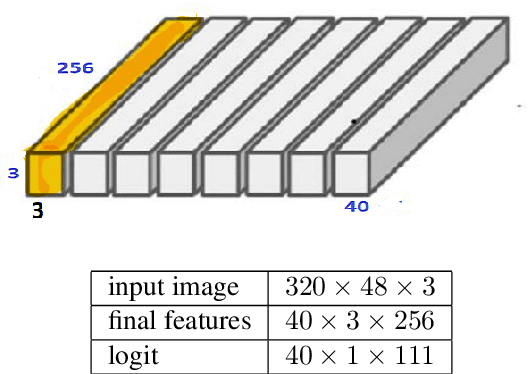
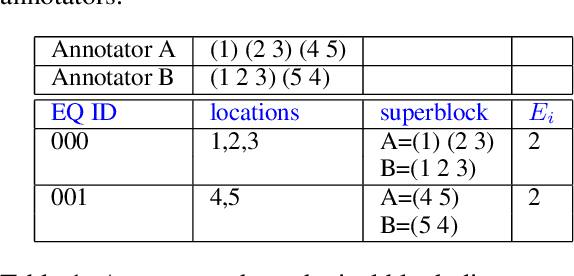
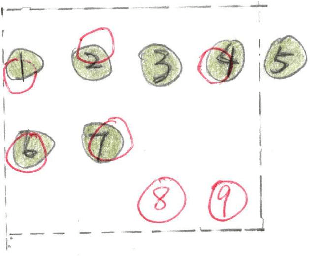

Abstract:This paper discusses the challenges of optical character recognition (OCR) on natural scenes, which is harder than OCR on documents due to the wild content and various image backgrounds. We propose to uniformly use word error rates (WER) as a new measurement for evaluating scene-text OCR, both end-to-end (e2e) performance and individual system component performances. Particularly for the e2e metric, we name it DISGO WER as it considers Deletion, Insertion, Substitution, and Grouping/Ordering errors. Finally we propose to utilize the concept of super blocks to automatically compute BLEU scores for e2e OCR machine translation. The small SCUT public test set is used to demonstrate WER performance by a modularized OCR system.
Episodic Memory Question Answering
May 03, 2022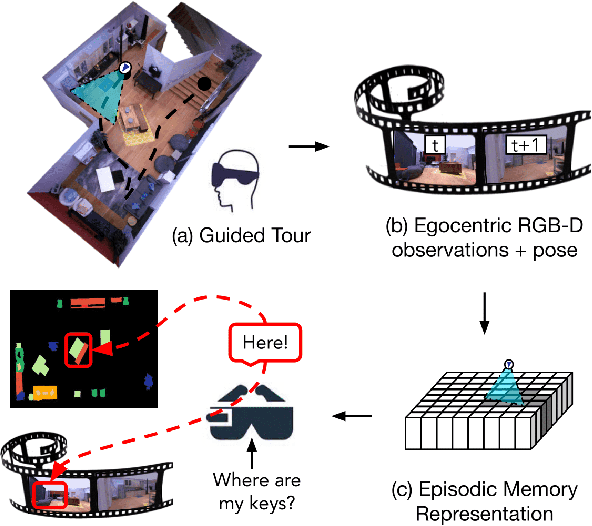

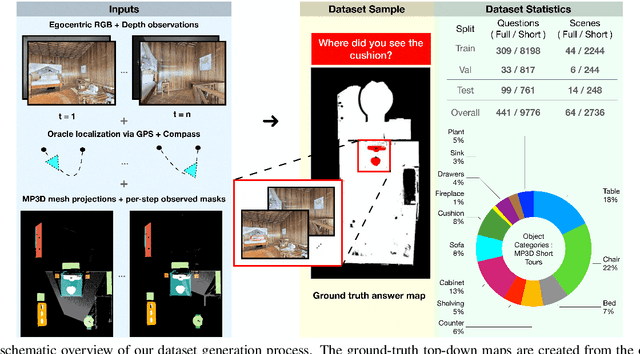

Abstract:Egocentric augmented reality devices such as wearable glasses passively capture visual data as a human wearer tours a home environment. We envision a scenario wherein the human communicates with an AI agent powering such a device by asking questions (e.g., where did you last see my keys?). In order to succeed at this task, the egocentric AI assistant must (1) construct semantically rich and efficient scene memories that encode spatio-temporal information about objects seen during the tour and (2) possess the ability to understand the question and ground its answer into the semantic memory representation. Towards that end, we introduce (1) a new task - Episodic Memory Question Answering (EMQA) wherein an egocentric AI assistant is provided with a video sequence (the tour) and a question as an input and is asked to localize its answer to the question within the tour, (2) a dataset of grounded questions designed to probe the agent's spatio-temporal understanding of the tour, and (3) a model for the task that encodes the scene as an allocentric, top-down semantic feature map and grounds the question into the map to localize the answer. We show that our choice of episodic scene memory outperforms naive, off-the-shelf solutions for the task as well as a host of very competitive baselines and is robust to noise in depth, pose as well as camera jitter. The project page can be found at: https://samyak-268.github.io/emqa .
Integrating Egocentric Localization for More Realistic Point-Goal Navigation Agents
Sep 07, 2020



Abstract:Recent work has presented embodied agents that can navigate to point-goal targets in novel indoor environments with near-perfect accuracy. However, these agents are equipped with idealized sensors for localization and take deterministic actions. This setting is practically sterile by comparison to the dirty reality of noisy sensors and actuations in the real world -- wheels can slip, motion sensors have error, actuations can rebound. In this work, we take a step towards this noisy reality, developing point-goal navigation agents that rely on visual estimates of egomotion under noisy action dynamics. We find these agents outperform naive adaptions of current point-goal agents to this setting as well as those incorporating classic localization baselines. Further, our model conceptually divides learning agent dynamics or odometry (where am I?) from task-specific navigation policy (where do I want to go?). This enables a seamless adaption to changing dynamics (a different robot or floor type) by simply re-calibrating the visual odometry model -- circumventing the expense of re-training of the navigation policy. Our agent was the runner-up in the PointNav track of CVPR 2020 Habitat Challenge.
Embodied Question Answering in Photorealistic Environments with Point Cloud Perception
Apr 06, 2019



Abstract:To help bridge the gap between internet vision-style problems and the goal of vision for embodied perception we instantiate a large-scale navigation task -- Embodied Question Answering [1] in photo-realistic environments (Matterport 3D). We thoroughly study navigation policies that utilize 3D point clouds, RGB images, or their combination. Our analysis of these models reveals several key findings. We find that two seemingly naive navigation baselines, forward-only and random, are strong navigators and challenging to outperform, due to the specific choice of the evaluation setting presented by [1]. We find a novel loss-weighting scheme we call Inflection Weighting to be important when training recurrent models for navigation with behavior cloning and are able to out perform the baselines with this technique. We find that point clouds provide a richer signal than RGB images for learning obstacle avoidance, motivating the use (and continued study) of 3D deep learning models for embodied navigation.
Align2Ground: Weakly Supervised Phrase Grounding Guided by Image-Caption Alignment
Mar 27, 2019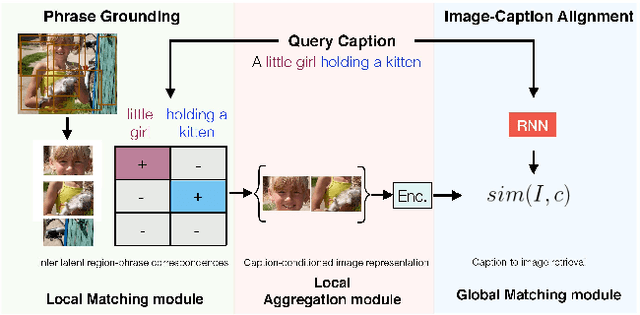



Abstract:We address the problem of grounding free-form textual phrases by using weak supervision from image-caption pairs. We propose a novel end-to-end model that uses caption-to-image retrieval as a `downstream' task to guide the process of phrase localization. Our method, as a first step, infers the latent correspondences between regions-of-interest (RoIs) and phrases in the caption and creates a discriminative image representation using these matched RoIs. In a subsequent step, this (learned) representation is aligned with the caption. Our key contribution lies in building this `caption-conditioned' image encoding which tightly couples both the tasks and allows the weak supervision to effectively guide visual grounding. We provide an extensive empirical and qualitative analysis to investigate the different components of our proposed model and compare it with competitive baselines. For phrase localization, we report an improvement of 4.9% (absolute) over the prior state-of-the-art on the VisualGenome dataset. We also report results that are at par with the state-of-the-art on the downstream caption-to-image retrieval task on COCO and Flickr30k datasets.
Unsupervised Learning of Face Representations
Mar 03, 2018


Abstract:We present an approach for unsupervised training of CNNs in order to learn discriminative face representations. We mine supervised training data by noting that multiple faces in the same video frame must belong to different persons and the same face tracked across multiple frames must belong to the same person. We obtain millions of face pairs from hundreds of videos without using any manual supervision. Although faces extracted from videos have a lower spatial resolution than those which are available as part of standard supervised face datasets such as LFW and CASIA-WebFace, the former represent a much more realistic setting, e.g. in surveillance scenarios where most of the faces detected are very small. We train our CNNs with the relatively low resolution faces extracted from video frames collected, and achieve a higher verification accuracy on the benchmark LFW dataset cf. hand-crafted features such as LBPs, and even surpasses the performance of state-of-the-art deep networks such as VGG-Face, when they are made to work with low resolution input images.
Embodied Question Answering
Dec 01, 2017



Abstract:We present a new AI task -- Embodied Question Answering (EmbodiedQA) -- where an agent is spawned at a random location in a 3D environment and asked a question ("What color is the car?"). In order to answer, the agent must first intelligently navigate to explore the environment, gather information through first-person (egocentric) vision, and then answer the question ("orange"). This challenging task requires a range of AI skills -- active perception, language understanding, goal-driven navigation, commonsense reasoning, and grounding of language into actions. In this work, we develop the environments, end-to-end-trained reinforcement learning agents, and evaluation protocols for EmbodiedQA.
 Add to Chrome
Add to Chrome Add to Firefox
Add to Firefox Add to Edge
Add to Edge